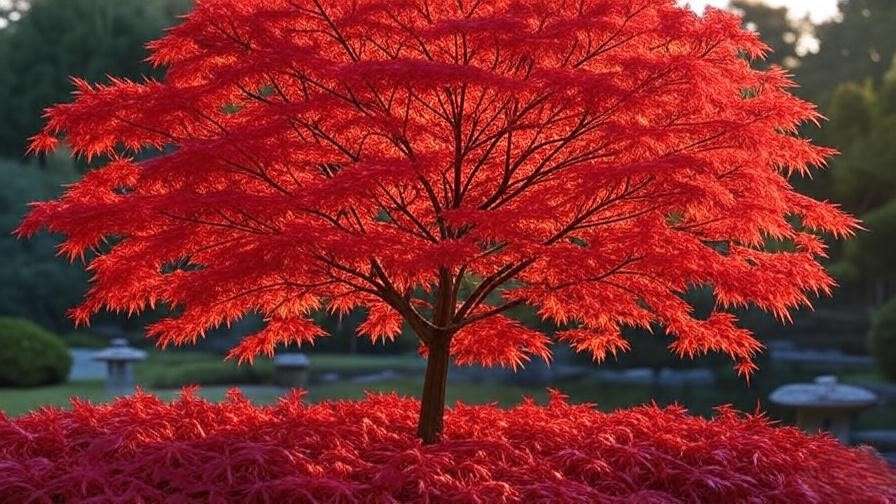Imagine stepping into your garden in autumn and being greeted by a blaze of fiery red leaves that seem to glow against the crisp fall sky. The Japanese Fireglow Maple Tree (Acer palmatum ‘Fireglow’) is a showstopper, transforming any landscape with its vibrant foliage and compact elegance. Whether you’re a seasoned gardener or a beginner dreaming of a stunning focal point, this guide unlocks the secrets to growing a healthy, breathtaking Japanese Fireglow Maple. With over a decade of experience in horticulture and tree care, I’ve cultivated these maples in diverse climates, and I’m excited to share expert tips to help you succeed. From planting to seasonal care, this comprehensive guide ensures your tree thrives, delivering jaw-dropping color year after year. 🌟
Understanding the Japanese Fireglow Maple Tree 🌟
What Makes the Japanese Fireglow Maple Special?
The Japanese Fireglow Maple, a cultivar of Acer palmatum, is prized for its intense red foliage that peaks in autumn, earning its “fireglow” name. Unlike other Japanese maples like ‘Bloodgood,’ which can grow taller, ‘Fireglow’ stays compact, reaching 8-12 feet tall and wide, making it ideal for small gardens, patios, or even containers. Its leaves emerge a soft green in spring, transition to a rich purple-red in summer, and explode into fiery scarlet in fall. This tree’s delicate, lacy leaves and graceful branching create a serene, almost Zen-like aesthetic, perfect for ornamental landscapes. 🌸
Native to Japan, Korea, and China, Japanese maples have been cultivated for centuries, and ‘Fireglow’ stands out for its hardiness and vivid color. Its moderate growth rate (1-2 feet per year) and adaptability make it a favorite among homeowners and landscape designers alike. Compared to other cultivars, ‘Fireglow’ offers a more intense red hue and better resistance to leaf scorch in warmer climates, provided it’s properly cared for.
Ideal Growing Zones and Climate Needs ☀️
The Japanese Fireglow Maple thrives in USDA Hardiness Zones 5-8, covering most temperate regions of the U.S. It prefers mild summers and cool winters, with ideal temperatures ranging from 60-75°F during the growing season. In colder zones (e.g., Zone 5), it can withstand winter temperatures as low as -20°F, while in warmer Zone 8, it needs protection from intense afternoon sun.
For gardeners in marginal zones, creating a microclimate can make all the difference. Planting near a north-facing wall or under taller trees provides shade and wind protection. If you’re in a hotter region, consider morning sun with afternoon shade to prevent leaf burn. Testing your soil’s drainage and pH (aim for 5.5-6.5) is crucial, as this tree despises “wet feet.” 🌿
Planting Your Japanese Fireglow Maple Tree 🌱
Choosing the Perfect Location
Location is everything for a thriving Japanese Fireglow Maple. This tree loves partial shade, ideally receiving 4-6 hours of filtered sunlight daily. Morning sun with afternoon shade is perfect, especially in warmer climates, to prevent leaf scorch. Avoid planting in open, windy areas, as strong gusts can dry out leaves and damage delicate branches.
Soil quality is equally important. Japanese maples need well-draining, slightly acidic soil rich in organic matter. If your soil is heavy clay or sandy, amend it with compost or peat moss to improve texture and drainage. A quick soil test (available at local garden centers or online) can confirm pH levels and guide amendments. For urban gardeners, ensure the site is free from reflected heat off buildings or pavement, which can stress the tree. ☀️
Step-by-Step Planting Guide
Planting your Japanese Fireglow Maple correctly sets the stage for long-term success. Follow these steps:
- Timing: Plant in early spring or fall when temperatures are cool, allowing roots to establish before extreme heat or cold.
- Prepare the Hole: Dig a hole twice as wide and as deep as the root ball. Loosen the soil to encourage root growth.
- Amend the Soil: Mix native soil with 30% organic compost or aged manure to boost nutrients and drainage.
- Planting Depth: Place the tree so the root flare (where roots meet the trunk) sits slightly above ground level. Backfill and tamp gently to remove air pockets.
- Mulch: Apply a 2-3 inch layer of organic mulch (like bark or wood chips) around the base, keeping it 2 inches from the trunk to prevent rot.
- Water: Water deeply after planting, ensuring the soil is moist but not soggy. 🌳
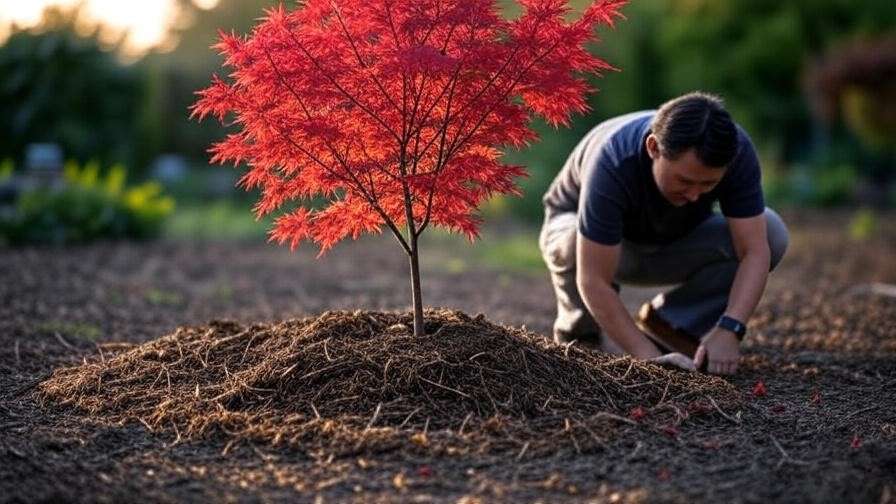
Container Planting for Small Spaces 🪴
For those with limited space, growing a Japanese Fireglow Maple in a container is a fantastic option. Choose a pot at least 18-24 inches in diameter with drainage holes to prevent waterlogging. Use a high-quality, well-draining potting mix designed for trees or shrubs, ideally with perlite or vermiculite for aeration.
Place the container in a spot with morning sun and afternoon shade, and rotate it every few months to ensure even growth. Containers dry out faster than garden soil, so check moisture levels regularly. A decorative pot can also elevate your patio’s aesthetic, making the tree a stunning focal point. 🌼
Essential Care Tips for a Thriving Japanese Fireglow Maple 🌳
Watering Needs for Optimal Growth 💧
Japanese Fireglow Maples need consistent moisture, especially during their first two years. Water deeply once or twice a week, ensuring the top 6-8 inches of soil stay moist but not waterlogged. In hot, dry weather, increase frequency, but always check the soil first—stick your finger 2 inches deep; if it’s dry, water.
Overwatering is a common mistake, leading to root rot. Signs include yellowing leaves or a mushy trunk base. Underwatering, on the other hand, causes wilted or crispy leaves. Use a soaker hose or drip irrigation for even watering, and adjust based on rainfall. In winter, reduce watering as the tree enters dormancy.
Fertilizing for Vibrant Foliage 🌼
Fertilizing enhances the Japanese Fireglow Maple’s vibrant colors and overall health. Use a slow-release, low-nitrogen fertilizer (e.g., 10-10-10 or 4-8-4) in early spring, just as buds begin to swell. Apply according to package instructions, typically 1-2 pounds per tree, spread evenly around the drip line.
Organic options like compost tea, fish emulsion, or well-rotted manure are excellent for eco-conscious gardeners. Avoid high-nitrogen fertilizers, which promote excessive leaf growth at the expense of color. Over-fertilizing can burn roots, so err on the side of caution. A second, lighter feeding in early summer can support growth in nutrient-poor soils.
Pruning and Shaping Your Tree ✂️
Pruning keeps your Japanese Fireglow Maple healthy and enhances its natural, graceful shape. The best time to prune is late winter or early spring before new growth begins. Use clean, sharp pruning shears to:
- Remove dead, damaged, or crossing branches.
- Thin crowded areas to improve air circulation.
- Shape the tree lightly to maintain its aesthetic form.
Avoid heavy pruning, as Japanese maples are slow to recover. Never remove more than 20% of the canopy in one season. For a layered, open look, focus on selective thinning rather than shearing. If you’re unsure, consult a certified arborist for professional shaping. 🌿
Mulching and Soil Care 🍂
Mulching is a game-changer for Japanese Fireglow Maples. A 2-3 inch layer of organic mulch (e.g., shredded bark, pine needles, or wood chips) conserves moisture, regulates soil temperature, and suppresses weeds. Apply mulch in a ring around the tree, extending to the drip line, but keep it away from the trunk to prevent rot.
Refresh mulch annually in spring, checking soil pH at the same time. If pH drifts above 6.5, add sulfur or organic matter to maintain acidity. Regularly inspect the soil for compaction, and aerate gently with a garden fork if needed to promote root health.
Seasonal Care for Year-Round Beauty 🍁
Spring Care: Kickstarting Growth 🌸
Spring is a critical time for your Japanese Fireglow Maple, as it emerges from dormancy and begins new growth. Start by inspecting the tree for winter damage—look for broken branches, frost cracks, or peeling bark. Prune any dead or damaged wood with clean, sharp shears, making cuts at a 45-degree angle just above a healthy bud. This encourages vigorous growth and maintains the tree’s shape.
Apply a balanced, slow-release fertilizer (like 10-10-10) in early spring to fuel new leaf development. Water consistently to support root expansion, ensuring the soil stays moist but not soggy. Keep an eye out for early-season pests like aphids or scale insects, which can target tender new shoots. A gentle spray of insecticidal soap or neem oil can deter these pests without harming beneficial insects. Regularly check for weeds around the base, as they compete for nutrients. 🌱
Summer Care: Protecting from Heat ☀️
Summer brings challenges for Japanese Fireglow Maples, especially in warmer climates. High temperatures and intense sunlight can cause leaf scorch, where leaf edges turn brown and crispy. To prevent this, ensure your tree gets afternoon shade, either naturally or with a temporary shade cloth during heatwaves. If planted in a container, move it to a shadier spot during peak summer heat.
Increase watering frequency during dry spells, aiming for deep irrigation once or twice a week. Check soil moisture by digging a small hole near the drip line; if the top 2 inches are dry, it’s time to water. Reapply mulch if it’s thinned out, as it helps keep roots cool and retains moisture. Avoid fertilizing in summer, as it can stress the tree during hot weather. Regularly inspect for spider mites, which thrive in dry conditions—look for fine webbing or stippled leaves and treat with a strong water spray or miticide if needed. 🌳
Fall Care: Maximizing Vibrant Color 🍂
Fall is when the Japanese Fireglow Maple truly shines, with its leaves turning a brilliant scarlet that rivals any autumn display. Cool nights and shorter days enhance this color, but proper care ensures the best show. Reduce watering slightly as the tree prepares for dormancy, but don’t let the soil dry out completely. Stop fertilizing by late summer to avoid pushing new growth that could be damaged by frost.
Rake fallen leaves regularly to prevent fungal diseases like powdery mildew, which can overwinter in debris. If your tree is in a windy area, consider staking young trees to protect against autumn storms. Take time to enjoy the foliage—snap photos and share them with fellow gardeners to inspire others! This is also a good time to plan for winter protection, especially for young or container-grown trees. 🍁
Winter Care: Ensuring Dormancy and Protection ❄️
Winter care focuses on protecting your Japanese Fireglow Maple from cold, wind, and frost. For trees in the ground, apply a fresh layer of mulch (3-4 inches) around the base to insulate roots. In colder zones (5-6), wrap the trunk of young trees with burlap or tree wrap to prevent frost cracks and sunscald, where winter sun warms the bark, causing it to split.
Container-grown maples are more vulnerable to freezing. Move pots to a sheltered spot, like a garage or against a house wall, and wrap them with bubble wrap or insulating blankets to protect roots. Water sparingly during dormancy, only when the soil is dry to the touch, as overwatering can lead to root rot. If you live in an area with heavy snow, gently brush snow off branches to prevent breakage. 🌨️
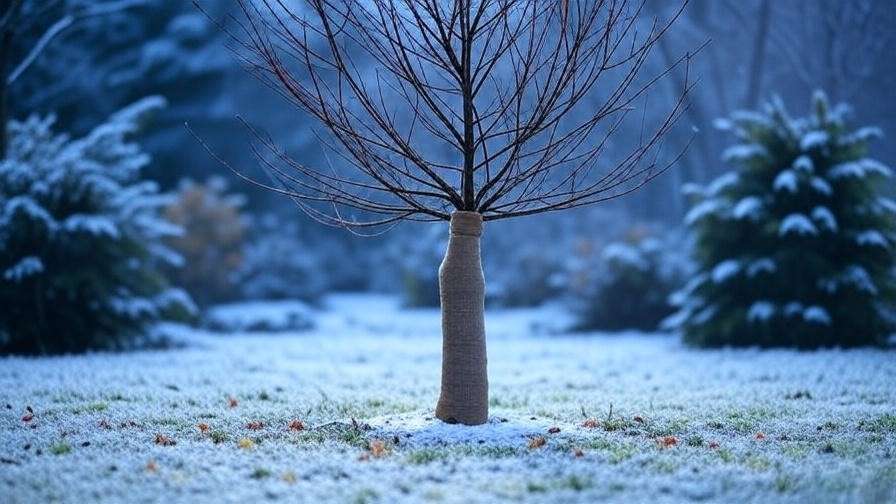
Common Problems and Solutions for Japanese Fireglow Maples 🐞
Identifying and Treating Pests
Japanese Fireglow Maples are relatively pest-resistant, but a few culprits can cause trouble. Aphids, tiny sap-sucking insects, cluster on new growth, leaving sticky residue. Spider mites, common in hot, dry conditions, create fine webs and stippled leaves. Scale insects appear as small, waxy bumps on stems or leaves.
For organic control, spray affected areas with neem oil or insecticidal soap, ensuring thorough coverage of leaf undersides. Repeat every 7-10 days until pests are gone. For severe infestations, consult a local extension service for chemical options, but use them sparingly to protect pollinators. Preventative measures include encouraging natural predators like ladybugs and maintaining good air circulation through proper pruning. Regular inspections, especially in spring and summer, catch problems early. 🌿
Addressing Diseases
Fungal diseases like verticillium wilt and powdery mildew can affect Japanese maples. Verticillium wilt, caused by soil-borne fungi, leads to wilting branches and yellowing leaves. Unfortunately, there’s no cure, but you can manage it by pruning affected branches (sterilize tools between cuts) and improving soil drainage. Powdery mildew, a white coating on leaves, thrives in humid, shady conditions. Treat it with a fungicide labeled for ornamental trees or improve air flow by thinning the canopy.
Sanitation is key: remove fallen leaves and debris to reduce fungal spores. Avoid overhead watering, which spreads disease. If your tree shows persistent issues, a soil test can identify underlying problems like poor drainage or nutrient imbalances. 🩺
Troubleshooting Leaf Issues 🍃
Leaf problems are a common concern for Japanese Fireglow Maple owners. Here’s how to diagnose and fix them:
- Leaf Scorch: Brown, crispy leaf edges often result from too much sun, wind, or insufficient water. Increase shade, adjust watering, and apply mulch.
- Yellowing Leaves: This can indicate overwatering, poor drainage, or nutrient deficiency. Check soil moisture and pH, and fertilize if needed.
- Premature Leaf Drop: Stress from drought, pests, or root damage is often the cause. Inspect roots for rot and ensure consistent care.
If problems persist, consult a certified arborist for a professional assessment. Documenting symptoms with photos can help with diagnosis. Patience is key—many issues resolve with proper care over time. 🌳

Design Ideas: Incorporating Japanese Fireglow Maples in Your Landscape 🌺
Creating a Focal Point in Small Gardens
The Japanese Fireglow Maple’s compact size and vibrant color make it a perfect focal point for small gardens. Plant it near a seating area or pathway to draw the eye. Pair it with low-growing shrubs like boxwood or perennials like hostas for contrast. For a Zen-inspired garden, surround it with smooth pebbles, a small water feature, or bamboo accents. Position the tree where its fall color will pop against evergreens or neutral backgrounds, creating a dramatic autumn display. 🌸
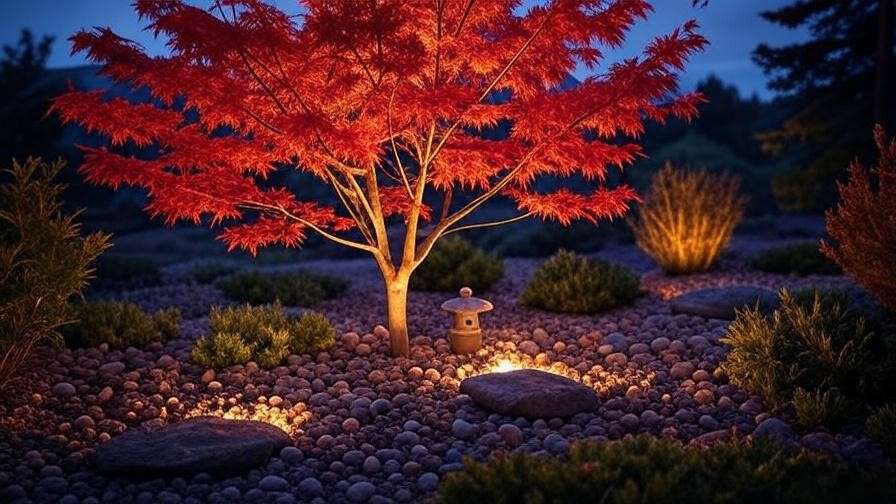
Container and Patio Displays 🪴
In urban or small spaces, a container-grown Japanese Fireglow Maple adds elegance to patios or balconies. Choose a ceramic or terracotta pot in muted tones to complement the tree’s foliage. Pair with seasonal flowers like pansies or mums for a dynamic display. Ensure the pot has drainage holes and elevate it slightly to prevent water pooling. Rotate the container every few months for even sunlight exposure, and use a saucer to catch runoff. This setup transforms even the smallest spaces into a vibrant oasis. 🌼
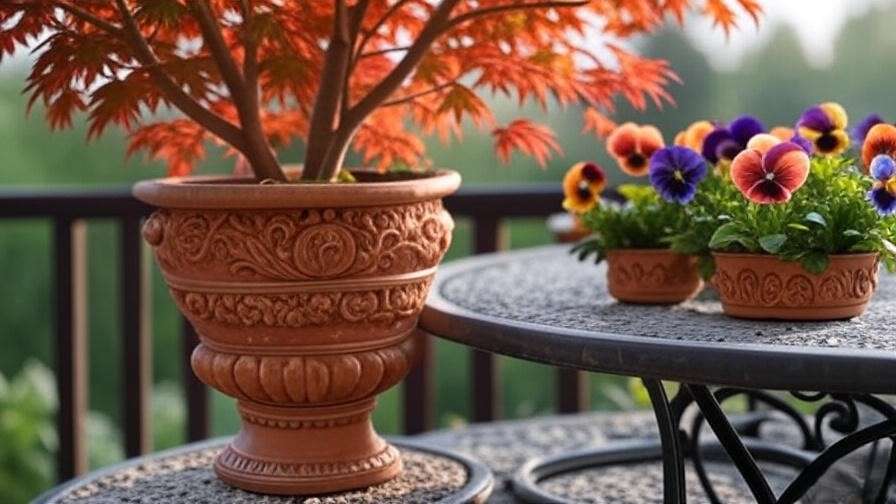
Companion Plants for a Cohesive Look 🌼
Companion planting enhances the Japanese Fireglow Maple’s beauty. Choose plants with complementary textures and colors, like:
- Hostas: Their broad, lush leaves contrast with the maple’s delicate foliage.
- Ferns: Soft, feathery fronds add a woodland vibe.
- Azaleas: Spring blooms in pink or white pair beautifully with the maple’s green leaves.
Avoid plants with aggressive roots, like bamboo or certain grasses, which can compete for water and nutrients. Arrange companions in a layered design, with taller plants at the back and shorter ones near the tree’s base, to create a balanced, harmonious look. 🌿
Expert Insights: Tips from Horticulturists 🌳
As a horticulturist with over 15 years of experience, I’ve seen Japanese Fireglow Maples thrive in diverse settings. One lesser-known tip is to incorporate mycorrhizal fungi into the soil at planting. These beneficial microbes form a symbiotic relationship with roots, improving nutrient and water uptake. You can find mycorrhizal inoculants at garden centers—sprinkle them in the planting hole for a head start.
Another pro tip: avoid planting near walnut trees, as their roots release juglone, a chemical toxic to maples. For eco-friendly care, use compost tea as a natural fertilizer—it’s gentle yet effective. A colleague, a certified arborist, once shared a success story: a client’s struggling Fireglow Maple was revived by correcting soil pH and adding a drip irrigation system, proving that small adjustments can yield big results. 🌟
FAQs: Answering Common Reader Questions ❓
The Japanese Fireglow Maple Tree sparks curiosity among gardeners, so here are answers to some of the most common questions to help you grow this stunning tree with confidence.
- How fast does a Japanese Fireglow Maple grow?
The Japanese Fireglow Maple is a slow to moderate grower, adding 1-2 feet per year under ideal conditions. It typically reaches its mature height of 8-12 feet in 5-10 years, depending on climate, soil, and care. Patience is key for this ornamental gem! 🌳 - Can it survive in full sun or full shade?
While it prefers partial shade (4-6 hours of filtered sunlight), it can tolerate full sun in cooler climates (Zones 5-6) if well-watered. In hotter regions (Zone 8), avoid full sun to prevent leaf scorch. Full shade may dull its vibrant fall color, so aim for a balance. ☀️ - How do I protect my tree from deer or rabbits? 🦌
Deer and rabbits may nibble on young Japanese Fireglow Maples. Use physical barriers like wire mesh or fencing around the trunk for young trees. Repellents with garlic or capsaicin can deter animals, but reapply after rain. Planting deer-resistant companions like lavender nearby can also help. - Is it suitable for bonsai cultivation?
Absolutely! The Japanese Fireglow Maple’s compact size and delicate leaves make it an excellent candidate for bonsai. Regular pruning and root trimming, along with a well-draining bonsai soil mix, are essential. Consult a bonsai expert for specific techniques to shape its stunning foliage. 🌿 - What’s the lifespan of a Japanese Fireglow Maple?
With proper care, these trees can live for 60-100 years or more, becoming cherished garden heirlooms. Consistent watering, soil care, and protection from extreme weather are key to longevity. - How do I propagate a Japanese Fireglow Maple?
Propagation is challenging but possible through softwood cuttings in early summer. Take 4-6 inch cuttings, dip in rooting hormone, and plant in a moist, well-draining medium. Keep in a humid, shaded area until roots develop (6-8 weeks). Grafting is another method, best left to professionals. 🌱
Conclusion: Growing Your Dream Japanese Fireglow Maple 🌟
The Japanese Fireglow Maple Tree is more than just a plant—it’s a living work of art that transforms your garden with its fiery autumn display and year-round elegance. By following this guide’s expert tips on planting, watering, fertilizing, pruning, and seasonal care, you’ll ensure your tree thrives, delivering vibrant color and serene beauty for decades. Whether you’re creating a Zen-inspired retreat, a patio centerpiece, or a small garden focal point, the Fireglow Maple is a versatile star. 🌺
Start your journey today: plant your tree, nurture it with care, and watch it become the heart of your landscape. Have questions or success stories? Share them in the comments below, and let’s inspire each other to grow stunning gardens! Explore our related articles, like “Top 10 Japanese Maples for Small Gardens” or “Fall Garden Prep Tips,” for more ways to elevate your outdoor space. 🌳

